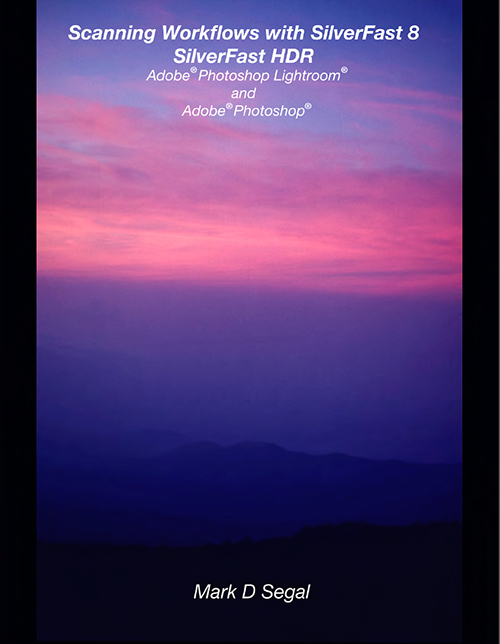Many of us have large legacy slide (or negative) collections that we periodically select slides from and scan. Unfortunately, along with the advances in computer hardware and operating systems has come the obsolescence and discontinued support for manufacturer’s scanning software. For example, the Nikon Scan software that drives the outstanding Nikon Super Coolscan 5000 ED scanner is not supported on Windows 7 (any version), Mac OS 10.5.x or later, or any 64- bit operating system (including 64-bit, 32-bit or Compatibility mode). Unless you have a legacy computer dedicated to scanning (and who wants to do that), SilverFast is here to save the day, and fortunately, my friend and colleague Mark D Segal has recently published the definitive guide to scanning slides and prints with SilverFast. Mark’s E-Book provides production-quality workflows that incorporate Silverfast 8, SilverFast HDR, and Adobe’s Lightroom and Photoshop applications.

Scanning Workflows with SilverFast 8, SilverFast HDR, Adobe Photoshop Lightroom and Adobe Photoshop © Mark D Segal
SilverFast has been one of the premiere applications for scanning film and prints since LaserSoft Imaging A.G. released Version 1.0 in 1995. The application grew and matured over the years, and is being used by very large numbers of people all over the world. In September 2011 the company released Version 8.0. This version is fully up-to-date with contemporary Macintosh and Microsoft computer operating systems and provides 64-bit compatible drivers for a number of scanners, including the Nikon CoolScan series and others. The SilverFast code and user interface have changed fundamentally, and for the better.
Over the last year of the redevelopment of SilverFast 8, Mark assisted LaserSoft Imaging as one of its foremost external beta testers. At the same time, Mark identified the need for a comprehensive book describing how to use the new application in its own right, and in the context of complementary external image editing applications such as Adobe Photoshop and Adobe Photoshop Lightroom.
As Mark put it, “So many people keep wondering what’s best to do where in a scanning workflow, because there are numerous options and conceivable workflow sequences, so how to manage all this successfully can be a bit bewildering. Then there are perennial questions about color management – how does one make sure that the scan preview on a monitor and the image that emerges from a printer will look about the same? So I decided that it would be worthwhile to produce a guide that not only provides clear instruction on every aspect of using SilverFast 8 and Silver HDR 8, but also how to integrate these applications into post-scan workflows.”
The result, Mark’s new book “Scanning Workflows with SilverFast 8, SilverFast HDR, Adobe Photoshop Lightroom and Adobe Photoshop,” is available for sale as a PDF download on the SilverFast website. Mark says in the Introduction: “This book is for anyone seeking to learn efficient workflows for maximizing image quality from scanned media.” The idea, Mark says, “is to provide instruction that will be useful to beginners and more advanced users alike.”
The coverage is comprehensive – 380 pages and many illustrations – and deals with:
- The SilverFast approach to scanning and application version differences, including guidance on what you get or miss between the versions;
- Understanding and managing the application interface;
- Understanding what items and tasks are more or less scanner-related;
- Deciding up-front what you will do in which application;
- Setting up the workflow structures enabling those decisions;
- Choosing your SF8 scan Preferences;
- Choosing your SF8 color management options and profiling your scanner;
- Loading the image into the scanner and adjusting the scan preview to suit;
- Dealing with resolution, bit-depth, print size, linear dimensions and file size;
- Image grain reduction, dust and scratch clean-up and sharpening;
- Making adjustments to image tonality (brightness and contrast);
- Bringing out deep shadow detail;
- Making adjustments to color (color balance and selective color adjustments);
- Handling Conversions: Color to Grayscale and Negative to Positive (for both color and grayscale);
- Workflow strategies step-by-step from A to Z;
- Automation (batch scanning).
The book’s index and first twenty-three pages are available as a free download on the SilverFast website, and the (259 MB) E-book can be purchased and downloaded from the site as well. I’ve read it, and I highly recommend it.
Tags: scanning, SilverFast

[…] https://www.wildnaturephotos.com/Blog/2012/05/scanning-workflows-with-silverfast-8/ […]